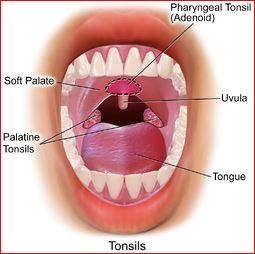Tonsillectomy
Peer reviewed by Dr Doug McKechnie, MRCGPLast updated by Dr Colin Tidy, MRCGPLast updated 20 Jan 2025
Meets Patient’s editorial guidelines
- DownloadDownload
- Share
- Language
- Discussion
In this series:Sore throatTonsillitisTonsil stonesGlandular fever
A tonsillectomy is an operation to remove the tonsils from the back of the throat. Other leaflets explain more about tonsils, sore throats and throat infections. This leaflet covers risks and benefits of the operation and what to expect before, during and after a tonsillectomy.
Note: the information below is a general guide only. The arrangements often vary between different hospitals. Always follow the instructions given by your doctor or local hospital.
In this article:
Continue reading below
What are tonsils?
Tonsils are lumps of soft tissue and are part of the immune system. You have two tonsils, one on either side at the back of the mouth. You can normally see your tonsils by opening your mouth wide and looking in a mirror. They are the two fleshy lumps that you can see at the sides and back of the mouth. Tonsils help to defend the body from infection. However, as there are other ways your body fights infection, your tonsils are not really needed.
Tonsils and adenoids diagram

By Blausen.com staff (2014). "Medical gallery of Blausen Medical 2014". WikiJournal of Medicine 1 (2). DOI:10.15347/wjm/2014.010. ISSN 2002-4436., CC BY 3.0, via Wikimedia Commons
What is a tonsillectomy?
A tonsillectomy is the surgical removal of the tonsils. In some cases the adenoids are also removed, in which case the operation is known as an adeno-tonsillectomy. Adenoids are made of similar tissue to tonsils and hang from the back of the nose, above your throat, where you cannot see them. They are also part of the immune system. They shrink on their own in childhood once they are no longer needed.
Tonsillectomy is an operation most often done in childhood; however, it can be done in adults as well. It is a common procedure.
See the separate leaflet What do tonsils do? There are other separate leaflets which may be relevant, called Tonsillitis and Sore throat.
Continue reading below
Benefits of tonsillectomy
Tonsils are usually removed because they are causing problems. Common reasons for taking tonsils out are:
Having to take a lot of time off from work or school as a result of repeated (recurring) attacks of infection of the tonsils (tonsillitis). If you have frequent or severe episodes of tonsillitis, having your tonsils removed stops this happening. However, it does not stop you having sore throats and other throat infections.
Recurring abscesses around the tonsil (called quinsy).
Tonsils (and/or adenoids) are getting in the way of the airway, making it difficult to breathe, sleep or eat. For example if you have a condition called obstructive sleep apnoea, removing tonsils and adenoids may be helpful.
Growths on the tonsil that need further investigation.
National guidelines indicate when it might be reasonable for a GP to refer someone for consideration of tonsillectomy. They suggest how frequently a person would have had a sore throat or tonsillitis to justify considering the risks of an operation. Current UK and American guidelines are shown below in the Further Reading section.
Risks of tonsillectomy
Tonsillectomy is a common operation which usually is very safe. However, ALL operations do have some risks. Postoperative complications may occur in some cases. Risks of a tonsillectomy include:
Risk from the anaesthetic. Being put to sleep (a general anaesthetic) is needed for a tonsillectomy. There is always a very small risk that problems may occur during a general anaesthetic.
Bleeding. Any operation where tissues are removed will cause some bleeding. This is stopped at the time of the operation but, occasionally, bleeding may restart in the hours or days afterwards. Sometimes this can be heavy bleeding which needs a further operation to get the bleeding under control.
Infection. The healing area in the throat is raw and prone to infection after the operation. To help prevent this, antibiotics will often be given around the time of the operation to reduce the risk of infection.
Pain. You can expect some pain for one or two weeks after a tonsillectomy. In some people this can be severe. You will normally be prescribed painkillers to take after the operation and when you go home.
Damage to the teeth or the jaw. Occasionally teeth may be damaged accidentally during the operation, as all the surgical instruments will be in the mouth very close by. It is important to let the doctor doing the anaesthetic (the anaesthetist) know if you have any crowns, caps or loose teeth. In some cases there may be pain in the jaw following it being stretched open during the operation.
Continue reading below
What happens before the tonsillectomy?
The hospital will provide information for you (or for your child) before the operation. Different hospitals have slightly different procedures; however, you should be told exactly what will happen and be given a leaflet to read.
Consent form. Before you sign the consent form to agree to the operation for you (or for your child), make sure you have asked all the questions you need to. You should be aware of the risks and the benefits and of what will happen during and after the operation. Discuss any worries or concerns you have. Only sign the consent form when you are happy to go ahead with the operation.
Anaesthesia. The anaesthetist will see you and explain the anaesthetic. See the separate leaflet called Anaesthesia. The anaesthetist will check your general health (or that of your child), carry out an examination and in some cases arrange some further tests. This is to check that you (or your child) are fit for the anaesthetic, and that it should be safe for the operation to go ahead.
No water or food. You (or your child) will not be able to eat or drink before the operation. You will be told by your hospital exactly when you should 'starve' from; however, it is normally from about six hours before the time of the operation. You can usually drink water up to two hours before the operation.
If your child is having a tonsillectomy, you will normally be with them in the anaesthetic room, if you wish, while they are being put to sleep. You will see them again after the operation, either in the recovery room as they wake up, or back on the ward.
What happens during the tonsillectomy?
The operation itself usually takes around half an hour. While you (or your child) are deeply asleep under general anaesthesia, the tonsils are removed. This operation can be done in several ways. These include:
Cold steel surgery. This is the most common method. The tonsils are physically cut out with a surgical knife. The bleeding is stopped by applying pressure or by applying heat (diathermy).
Diathermy. A heat probe called a diathermy probe is applied to the tonsils. This destroys the tissue and seals the blood vessels to stop the bleeding.
Coblation (radiofrequency ablation). This works in a similar way to diathermy but uses a lower temperature.
Lasers and ultrasound waves. High-energy waves are used to cut out the tonsils and seal the blood vessels.
Tonsillectomy recovery
You (or your child) will wake up in the recovery room, where you will be monitored as you wake up. You (or your child) will have to stay in hospital for a few hours to be monitored. It is usual to be able to go home the same day (day case), or stay in hospital overnight and be discharged the next day.
Pain relief
It is normal to have a very sore throat after a tonsillectomy. Pain may also be felt in the ear due to the way the nerves are connected. Take regular painkillers until the pain starts to ease. If your child had the operation, give him/her pain relief every four to six hours for at least the first day or two regularly, rather than waiting to see if he/she is in pain. Painkillers will probably be needed for one to two weeks.
Usually paracetamol and/or ibuprofen will be sufficient. Adults may need a stronger painkiller such as cocodamol. The hospital should give you (or your child) suitable painkillers when you go home. Pain may get worse a few days after the operation before improving again gradually. This is a normal part of the healing process.
Eating and drinking
You (or your child) can start to eat and drink normally as soon as you feel able after the operation. It is fine to eat hard foods, such as toast or cereals. These are even helpful as they help to scrape away some of the debris from the operation. It is important to drink plenty of fluid, even if it is difficult to eat. You (or your child) may find chilled drinks soothing.
Brushing teeth
Brush your teeth as usual. It may be difficult to persuade your child to brush their teeth after the operation as their mouth will feel sore. It is important to keep brushing teeth, as it helps to keep the mouth free from germs. It also freshens the mouth.
Going back to work
You should be given a sick note when you leave hospital if you need one. Normally you will be off work for one to two weeks after the operation.
Going back to school
Children are normally off school or nursery for one to two weeks after a tonsillectomy. This is because they need the time to recover and they need regular painkillers. Also it is best not to mix with lots of other children at this time because they are more likely to pick up colds and other germs. While the throat is healing it is more vulnerable to infection.
When to seek advice
A thick white or yellow coating to the back of the throat is normal for a week or two after the operation. This is part of the healing process and does not indicate an infection.
If a high temperature (fever) develops in the week or two after a tonsillectomy, see your GP as soon as possible. This may suggest infection, and treatment with antibiotics may be necessary.
If there is any fresh bleeding from the back of the throat after a tonsillectomy you should contact your GP urgently. Attend Accident and Emergency or call 999/112/911 if there is a lot of bleeding. A little bit of brown 'old blood' coughed or vomited up is common and normal, but report any fresh red blood. Also if there is more than a little bit of brown blood, seek advice.
If painkillers are not working, and it is not possible to eat or drink, discuss with your GP as soon as possible.
Patient picks for Throat and tonsils

Ear, nose and throat
Laryngitis
Laryngitis is an inflammation of the mucus membranes of your voice box (larynx), which causes you to have a hoarse voice. It is most commonly due to an infection, usually a virus.
by Dr Rosalyn Adleman, MRCGP

Ear, nose and throat
Tonsillitis
Tonsillitis is an infection of the tonsils that causes them to become swollen and sore. It is usually caused by a virus, but can also be caused by bacterial infections. Most cases improve within a week with rest, fluids, and pain relief, however, bacterial tonsillitis may require antibiotics. This leaflet discusses the symptoms, causes, treatments, and when to see a doctor.
by Dr Philippa Vincent, MRCGP
Further reading and references
- Randall DA; Current Indications for Tonsillectomy and Adenoidectomy. J Am Board Fam Med. 2020 Nov-Dec;33(6):1025-1030. doi: 10.3122/jabfm.2020.06.200038.
- Tonsillectomy - Commissioning Guide; ENT UK and Royal College of Surgeons, 2021
- Burton MJ, Glasziou PP, Chong LY, et al; Tonsillectomy or adenotonsillectomy versus non-surgical treatment for chronic/recurrent acute tonsillitis. Cochrane Database Syst Rev. 2014 Nov 19;(11):CD001802. doi: 10.1002/14651858.CD001802.pub3.
- Xu B, Jin HY, Wu K, et al; Primary and secondary postoperative hemorrhage in pediatric tonsillectomy. World J Clin Cases. 2021 Mar 6;9(7):1543-1553. doi: 10.12998/wjcc.v9.i7.1543.
- Mitchell RB, Archer SM, Ishman SL, et al; Clinical Practice Guideline: Tonsillectomy in Children (Update)-Executive Summary. Otolaryngol Head Neck Surg. 2019 Feb;160(2):187-205. doi: 10.1177/0194599818807917.
Continue reading below
Article history
The information on this page is written and peer reviewed by qualified clinicians.
Next review due: 19 Jan 2028
20 Jan 2025 | Latest version

Ask, share, connect.
Browse discussions, ask questions, and share experiences across hundreds of health topics.

Feeling unwell?
Assess your symptoms online for free
Sign up to the Patient newsletter
Your weekly dose of clear, trustworthy health advice - written to help you feel informed, confident and in control.
By subscribing you accept our Privacy Policy. You can unsubscribe at any time. We never sell your data.